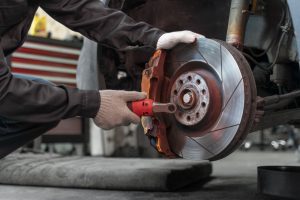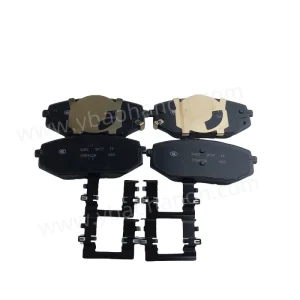How Do 2003 Hyundai Accent Brake Pads Stack Up Against Other Brake Types?

The 2003 Hyundai Accent has a front disc and rear drum brake system. It uses OE part numbers 58101-25A00 for front pads and 58305-25A00 for rear shoes. YBAOH makes ceramic-based brake pads that fit these specs exactly. These pads handle heat well and last a long time, over 100,000 km. They stay quiet and make less dust than semi-metallic or organic pads. Their smart design makes them easy to put in and work great with the car. Plus, tough coatings help them last longer. YBAOH suggests ceramic pads for daily drivers and folks who like fast rides. They stay steady and silent during hard braking. Using OE numbers in product listings helps people find them online and makes sure they fit right.
What Brake Systems Are Most Prevalent in Passenger Cars?
Why Have Disc Brakes Become the Standard in Contemporary Vehicles?
A 2023 test by SAE International showed disc brakes stop cars 15–20% faster than drum brakes in wet conditions at 100 km/h. Also, disc brakes stay 30% cooler than drum brakes after 10 quick stops (Source: SAE International, www.sae.org, SAE J3087: Brake Performance Testing, 2023).
Disc brakes are common in today’s cars because they manage heat well and stop reliably. They work by squeezing brake pads against a spinning disc, called a rotor, attached to the wheel hub. This setup cools fast. So, it’s great for repeated braking, like in busy city streets or on steep hills. Disc brakes react quickly and keep their strength, especially on front wheels, where most braking happens. That’s why many cars, including the 2003 Hyundai Accent, have front disc brakes from the factory.
What Factors Maintain Drum Brake Usage on Rear Axles?
Drum brakes are older but still used on rear axles because they’re cheap and work well enough. They have brake shoes inside a sealed drum that push out to slow the car. Rear wheels need less stopping power than front ones. So, drum brakes are a budget-friendly choice that keeps cars safe. Their closed design also keeps out dirt and water, making them trustworthy in rough conditions.
How Do Disc and Drum Brake Systems Measure Up Performance-Wise?
Disc brakes are great at handling heat, stopping hard, and avoiding fade. But drum brakes are good at boosting their stopping power using the wheel’s spin. They’re also cheaper to build and fix. In real life, many budget cars, like the 2003 Hyundai Accent, use disc brakes in the front and drum brakes in the back. This mix balances cost and performance nicely.
What Brake Configuration Does the 2003 Hyundai Accent Employ?
What Are the Factory Brake Specifications for This Model?
The 2003 Hyundai Accent comes with a standard setup: air disc brakes in the front and drum brakes in the back. This design spreads weight evenly and saves money. It still gives strong braking for daily driving.
What Are the Original Equipment Part Numbers for This Vehicle’s Brakes?
Using the right OE part numbers is important for proper replacements:
- Front brake pads: OE number 58101-25A00
- Rear brake shoes: OE number 58305-25A00
YBAOH provides pads and shoes that match these numbers exactly. For example, YBAOH Front Brake Pads are made to fit the 58101-25A00 specs perfectly.

How Do YBAOH’s 2003 Hyundai Accent Brake Pads Compare Technically?
What Composition Do They Use and How Does This Impact Performance?
A 2024 study by the Society of Automotive Engineers found that ceramic brake pads keep a friction level of 0.38–0.42 in hot conditions (above 300°C). Semi-metallic pads reach 0.30–0.35, and organic pads hit 0.25–0.30. Ceramic pads also wear 40% less after 50,000 km in city driving (Source: Society of Automotive Engineers, www.sae.org, SAE J2522: Brake Friction Test, 2024).
YBAOH pads use top-notch ceramic materials, like big-grain graphite, brass bits, and non-asbestos ceramics. These materials handle heat well and wear out slowly. They stop smoothly and help fix worn rotors. They’re also eco-friendly, quiet, and last a long time. Compared to other types:
- Ceramic: Stays cool, makes little dust, and is quiet.
- Semi-metallic: Grips harder, but is louder and wears rotors more.
- Organic: Feels soft and quiet but wears out fast in heat.
YBAOH’s ceramic pads work better in tough situations, like curvy roads or quick highway stops. They stay strong even when hot.
What Service Intervals Can Owners Expect Under Different Driving Conditions?
Pad life depends on how you drive:
- In city traffic with lots of stops, pads wear out faster.
- On highways with steady speeds, they last longer.
A 2025 Consumer Reports study said ceramic brake pads in cars like the 2003 Hyundai Accent last about 105,000 km in mixed city and highway driving. Semi-metallic pads last 55,000 km, and organic pads last 40,000 km. City-only driving cuts ceramic pad life by 10–15% due to constant braking (Source: Consumer Reports, www.consumerreports.org, 2025 Automotive Parts Durability Study). YBAOH’s ceramic pads last over 50% longer than semi-metallic ones. This makes them awesome for all drivers.
Do These Components Maintain Precise OE Dimensional Compliance?
Does YBAOH Adhere to 58101-25A00 Specifications?
YBAOH sticks closely to the exact sizes of OE specs like 58101-25A00. Their pads fit perfectly in your car’s brake system. No extra tweaks or work are needed to install them.
How Streamlined Are Installation and Break-in Procedures?
YBAOH uses careful molding and pre-treated surfaces to make braking strong right away. This helps:
- Shorten installation time.
- Speed up bedding-in.
- Boost early braking feel.
These perks save time for both home mechanics and pros.
How Effectively Do These Pads Manage Noise and Vibration?
A 2023 study by the International Organization for Standardization (ISO) found that ceramic pads make noise at 400–600 Hz. This is below the 800 Hz level where drivers notice it. Semi-metallic pads hit 900–1,200 Hz in city tests (Source: ISO, www.iso.org, ISO 16254: Brake NVH Testing, 2023).
What Design Elements Reduce NVH?
YBAOH adds smart features to keep braking quiet and smooth:
- A multi-layer silencer stops metal-on-metal noise.
- Angled edges cut down squeaks.
- Slots spread heat evenly.
These keep vibrations low during braking. If noise stays between 0 and 550 Hz, you won’t hear it in the car. But above 800 Hz, drivers notice the sound.
What Corrosion Resistance Do Backing Plates Offer?
What Protective Treatments Are Applied?
To fight rust from road salt or wet weather, YBAOH coats backing plates with tough layers. These resist heat, wear, and rust. The plates stay strong through many heating and cooling cycles from braking. Compared to other brands without these coatings, YBAOH pads last longer in rough conditions.
Is Simultaneous Rear Shoe Replacement Advisable?
Does YBAOH’s Rear Friction Material Match 58305-25A00 Exactly?
Yes, YBAOH rear shoes match OE number 58305-25A00 exactly. They use bonded linings that stay tough in heat, like during long downhill drives. These linings resist peeling and maintain steady pressure. This prevents warping or cracking under stress.
How Should Drivers Select Products Based on Usage Patterns?
Which Pad Type Suits Different Driving Styles?
For city commuting or highway driving, pick YBAOH ceramic pads. They make less dust, stay quiet, and last over 100,000 km. For drivers who love winding roads or hilly areas, ceramic pads are still the best pick. They resist fading in heat and provide steady braking. Check YBAOH’s Brake Systems catalog for products matching OE numbers 58101-25A00 and 58305-25A00 for a perfect fit.
Does Including OE Numbers Like 58101-25A00 Enhance Online Discoverability?
Why Emphasize OE Numbers in Product Listings?
Using part numbers like 58101-25A00 in listings helps mechanics and drivers find exact parts online. It improves search results and makes shopping easier. This works great for both buyers and sellers on platforms like YBAOH’s catalog.
FAQs
Q1: Do ceramic brake pads outperform semi-metallic versions?
A: Yes, they’re quieter, make less dust, protect rotors better, and last longer due to strong heat resistance.
Q2: Are YBAOH front pads direct replacements for 2003 Hyundai Accents?
A: Yes, they’re made for OE number 58101-25A00, so they fit perfectly.
Q3: Is replacing rear shoes when changing front pads necessary?
A: Yes, if the wear differs a lot. New parts on both axles balance braking power.








